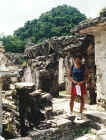Palenque, Chiapas, Mexico
The ancient Mayan city of Palenque, with its superb jungle setting and exquisite architecture and decoration, is one of the marvels of Mexico ... [First] occupied around 100 BC, [it] flourished from about 600 to 700 AD, and what a glorious century that was! The city rose to prominence under Pakal, a club-footed king who reigned from 615 to 683 AD ... represented by hieroglyphs of sun and shield, he is also referred to as Sun Shield or White Macaw ... During Pakal's reign, many plazas and buildings, including the superlative Templo de las Inscripciones (his Mausoleum), were constructed in Palenque ... [they are] characterized by ... very fine stucco bas-reliefs.
[Pakal's son Chan-Bahlum II] continued Palenque's political and economic expansion and the development of its art and architecture ... [and] presided over the construction of the Grupo de la Cruz temples, placing sizable narrative stone stelae within each. One can see the influence of Palenque's architecture in the Mayan city of Tikal ... The rival Mayan city of Toniná's hostility was perhaps the major factor in Palenque's precipitous decline after Chan-Bahlum II's death in 702. Sources speak of a devastating Toniná attack on Palenque in 730. After the 10th cent. Palenque was largely abandoned. In an area that receives the heaviest rainfall in Mexico, the ruins lay undiscovered until the 18th century. Frans Blom, an early-to-mid-20th century investigator remarked: 'The first visit to Palenque is immensely impressive. When one has lived there for some time this ruined city becomes an obsession.'
Ancient Palenque's 500 buildings are spread over 15 sq km but only a relatively few, in a fairly compact central area, have been excavated. Everything you see here was built without metal tools, pack animals or the wheel. The site stands at the precise point where the first hills rise out of the Gulf coast plain, and the dense green jungle covering these hills forms a superb backdrop to Palenque's outstanding Maya architecture. The forest is home to toucans, ocelots and monkeys; you may hear the howler monkeys especially if you stay at a campground nearby ... try to picture the gray stone edifices as they would have been at the peak of Palenque's power: painted bright red. [- Adapted from Lonely Planet Mexico.]
Ruina, Ruinas!  |
El Palacio ... 1  |
2 
|
3 (1993)  |
Templo de las Inscripciones ... 1  |
2  |
||
3  |
4 (1993)  |
||
5  |
Grupo de la Cruz  |
Templo de la Cruz  |
From Grupo de la Cruz  |
Visitor  |
Solstice tower  |
||
View from the top  |
Templo del Conde  |
||
Grupo Norte ... 1  |
2  |
3  |
Ruins in the jungle  |
Palenque Project: "presented by the Pre-Columbian Art Research Institute, Merle Greene Robertson and Mesoweb, the official homepage of a current archaeological dig." Lords of Palenque: "publication examines the hieroglyphic texts of Palenque to determine characteristics of the rulers of Palenque." | |||
Designed in collaboration with Vitalect, Inc. All rights reserved. |








